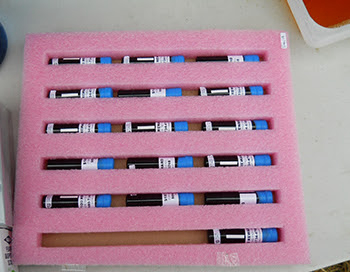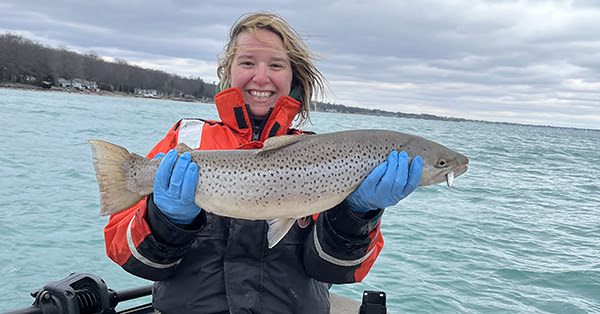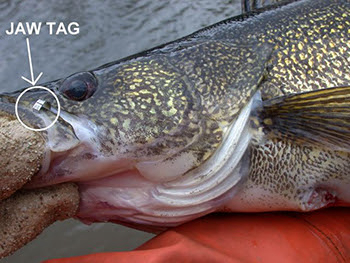New study of Saginaw Bay walleye movement and reproduction starts soon

A new study begins this month on Saginaw Bay, using acoustic transmitters that will be implanted in walleye to help researchers with the Michigan Department of Natural Resources, Michigan State University and several partner agencies obtain data about where the fish spawn.
Fish in such telemetry projects have acoustic transmitters affixed to them. Each transmitter then beeps a fish-specific code every few minutes. Acoustic receivers deployed in Lake Huron decode the tag beeps and log when fish tags are detected. The network of acoustic receivers in Saginaw Bay includes receivers in the mouths of rivers to listen for tagged fish moving to spawning grounds and receivers in Saginaw Bay to determine where walleye may be spawning.
Having a better understanding of relative sources of natural reproduction for walleye will help fishery managers determine which rivers and reefs to protect and, when needed, where to invest in actions that enhance and improve fish habitat.
Volunteer charter boat operations are assisting in the study by collecting the walleye hook and line in May while the fish from all spawning sources are mixed post-spawn, but before any leave the bay. Then when the fish return for spawning next spring, their locations will be logged in the receivers. There are at least 15 rivers and five offshore reefs that are likely sources of walleye spawning.
“The recovery of the Saginaw Bay walleye population is one of the great fishery management success stories of our time,” said Dave Fielder, a DNR fisheries research biologist. “However, we don’t fully know where all that natural reproduction takes place.”
Implanting the transmitters
Plans call for 150 walleye to be outfitted with transmitters this year, plus 200 more in 2023. The surgical procedure includes immobilizing the fish using low-voltage electricity and implanting a transmitter in the body cavity through a small incision on the underside of the fish. The incision is closed with sutures and, after a brief recovery, the walleye is released back in the bay. The entire process takes only a few minutes. In addition to the transmitter, each fish will receive an external “Floy Tag” – a long, colored, plastic tag visible to anyone catching the fish. A $100 reward is offered for the return of an internal transmitter. Tagged fish can be returned by calling 989-686-3645.
A previous telemetry study of Saginaw Bay walleye revealed that about one-third of the fish leave Saginaw Bay while the rest remain in the bay year-round. The fish that migrate out return to the bay in the fall and will overwinter in the bay, spawn, and migrate again the next year.
“We are eager to discover if the walleye prone to migrating are all coming from certain reproductive sources (certain rivers or reefs) or if they are simply mixed in with all the rest of the walleye population,” said Fielder.
The study has many agency partners and is led by Chris Vandergoot, an MSU fisheries research biologist, and coordinated by the Great Lakes Acoustic Telemetry Observing System – Vandergoot also serves as GLATOS director – and the Great Lakes Fishery Commission. Other assisting partners include the U.S. Geological Service’s Biological Resource Division and the Ohio DNR. The study is funded by Michigan Sea Grant.
More on fisheries studies
In addition to this walleye study, a lake sturgeon telemetry study will take place in Saginaw Bay this year, with emphasis on learning where juvenile lake sturgeon are moving and inhabiting. That GLATOS study is led by the U.S. Fish and Wildlife Service. The two studies will share the network of acoustic receivers in the bay and out in Lake Huron. There are additional telemetry studies taking place in Lake Huron; learn more about them at https://glatos.glos.us/.
To learn more about how the DNR manages the state’s fisheries, visit Michigan.gov/Fishing.
Contact: Dave Fielder (DNR), 989-590-8956 or Chris Vandergoot (MSU), 734-780-6010





